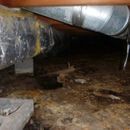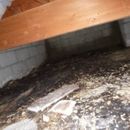Damp crawl space in a dry locale
Hi all,
I came across a damp crawl space in an eastern Arizona home (Show Low, warm summer Mediterranean (Koppen classification: Csa). The dirt crawlspace floor is damp to the point of transferring bulk moisture into the knees of my pants, with mold covering a lot of the attic floor. (I backed out and put on PPE before proceeding.)
I counted four 14×10 vents at its perimeter. Efflorescence and moisture stains are present the crawlspace’s block perimeter. The homeowner mentioned drainage problems, though the ground surrounding the house is dry. Also, the dryer is venting into the crawl. (Obviously adds to the problem, but how much?)
If the home were in Phoenix, I think the solution would be to ventilate and insulate. But in this colder climate (summer lows in the 60s, winter lows in the 20s), I’m leaning toward encapsulating/sealing.
I appreciate any and all thoughts.
Jason
GBA Detail Library
A collection of one thousand construction details organized by climate and house part











Replies
Jason,
I think that all the usual advice given to anyone with a damp crawl space applies here, even if the climate is fairly dry. This could be ground moisture, or bad drainage of roof runoff. The dryer vent is clearly contributing to the problem.
Solutions probably include some or all of the following: check the grade around the exterior of the building; check the roof gutters and conductor pipes, and remedy as needed (the discharge from the conductor pipes needs to be far from the foundations); re-route the dryer vent to the exterior; install 6-mil or thicker polyethylene on the crawl space floor; insulate the crawl space walls.
For more information, see:
Building an Unvented Crawl Space
Fixing a Wet Basement
It might be just the usual stuff Martin pointed you to, but it looks and sounds bad enough, in a dry enough climate, that I'm suspicious of something out of the ordinary, like a slow leak in the water line coming into the house, or the sewer going out. Unless they do a lot of laundry.
While you're at it, rip all of that failing plastic duct tape off the uninsulated duct (or is that the dryer vent?) and seal any & all joints & seams with duct mastic. Even the slip-joints of the ells are leaking air. It's hard to tell how bad off the insulated ducts are for air leakage, but if you can tighten them up too you should. The air leakage is not only an energy use/efficiency problem, if it's sucking any of the bad crawlspace air into the ducts (which it surely is, if the uninsulated duct is the return) it's an indoor air quality problem.
The staining on the back wall of the setback section in that first picture looks as if you may have a significant surface drainage (or pipe leak) issue over there.
At least the joists look clean and mold-free!
It doesn't appear as if there is any insulation on the sub-floor. For your (likely) climate zone 5B R30 between the joists would meet IRC 2012 code, but with the ducts in the crawlspace you're probably better off air sealing & insulating the crawl. To meet IRC 2012 in zone 5 takes R15 contiuous insulation at the foundation walls & band joist and R10 for the first 4' below grade, or a 4' wide strip of R10 around the perimeter, but R7.5-8 continuous foam under a non-structural rat slab (with a ground vapor barrier) would be better. If you do the floor first with 2" of EPS all the way to the foundation with 6 mil poly up a foot or so onto the foundation, you can then use 2.5" polyiso on the walls without worrying about ground moisture wicking into the cut edge of the polyiso.
http://publicecodes.cyberregs.com/icod/irc/2012/icod_irc_2012_11_sec002.htm
As always, you all are a great help. I was leaning toward sealing & insulating the crawl, but wasn't sure given the climate. I will move forward with recommending that the contractor do so. Thanks to all.